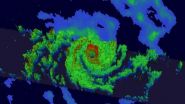(Press-News.org) VIDEO:
On March 23 when the TRMM satellite passed over Gillian, it was at hurricane-force. TRMM revealed intense storms in a well-defined eye wall producing rain at a rate of over...
Click here for more information.
Tropical Cyclone Gillian was near peak intensity when the Tropical Rainfall Measuring Mission or TRMM satellite passed overhead and saw towering thunderstorms and very heavy rainfall in the storm on March 23. By March 26, Gillian had weakened to a tropical storm and was quickly dissipating.
On March 23, Tropical Cyclone Gillian was a Category 5 hurricane on the Saffir-Simpson scale when NASA-JAXA's Tropical Rainfall Measuring Mission or TRMM satellite passed overhead. TRMM flew over Gillian during its peak wind speed near 140 knots/161.1 mph/259.3 kph on March 23 at 03:04 UTC.
Data from TRMM's Microwave Imager (TMI) and Precipitation Radar (PR) instruments were used to create a rainfall analysis. TRMM PR revealed that Gillian had very intense storms in a well defined eye wall producing rain at a rate of over 100mm/3.9 inches per hour. TRMM PR showed that some of the tall storms on the southwestern side of Gillian's eye were reaching heights of about 14 km/8.7 miles.
On March 25 at 2100 UTC/5 p.m. EDT, Tropical Cyclone Gillian's maximum sustained winds were down to 40 knots, but strong vertical wind shear was pounding the storm and severely affecting the structure of the storm. At that time it was centered near 21.0 south latitude and 103.5 east longitude, about 596 nautical miles/685.9 miles/1,104 km west of Learmonth, Australia. At that time, Gillian was moving over the open waters of the Southern Indian Ocean in a south-southwesterly direction and was quickly dissipating.
INFORMATION:
Text credit: Hal Pierce / Rob Gutro
NASA's Goddard Space Flight Center
NASA catches Gillian as a super-cyclone before quickly dissipating
2014-03-26
ELSE PRESS RELEASES FROM THIS DATE:
Rice U. study: Don't shop for travel at work
2014-03-26
HOUSTON – (March 26, 2014) –It is probably not a good idea to shop for leisure travel from the office during business hours, according to a new study from Rice University and Iowa State University.
Using data from a major online hotel reservation site, the study examined the quality of the hotel that consumers chose for their vacations and subsequently how satisfied they were with their stay. They found that consumers who traveled farther and made reservations during business hours were more likely to select higher quality hotels but were less satisfied after their stay. ...
Dark energy hides behind phantom fields
2014-03-26
Quintessence and phantom fields, two hypotheses formulated using data from satellites, such as Planck and WMAP, are among the many theories that try to explain the nature of dark energy. Now researchers from Barcelona and Athens suggest that both possibilities are only a mirage in the observations and it is the quantum vacuum which could be behind this energy that moves our universe.
Cosmologists believe that some three quarters of the universe are made up of a mysterious dark energy which would explain its accelerated expansion. The truth is that they do not know what ...
Albert Einstein College of Medicine researchers present at AACR Annual Meeting symposia
2014-03-26
March 26, 2014 – (BRONX, NY) – From uncovering the role nerve cells play in metastasis to identifying new cancer-causing genes, researchers at Albert Einstein College of Medicine of Yeshiva University made notable advances in the understanding and potential treatment of cancer during the past year.
Several Einstein faculty members and students will present their recent research at the American Association for Cancer Research (AACR) Annual Meeting, taking place in San Diego April 5-9, 2014. Among the presentations are those during major and mini symposia:
Gene Regulation ...
Gout isn't always easy to prove: CT scans help catch cases traditional test misses
2014-03-26
Rochester, Minn. — Gout is on the rise among U.S. men and women, and this piercingly painful and most common form of inflammatory arthritis is turning out to be more complicated than had been thought. The standard way to check for gout is by drawing fluid or tissue from an affected joint and looking for uric acid crystals, a test known as a needle aspirate. That usually works, but not always: In a new Mayo Clinic study, X-rays known as dual-energy CT scans found gout in one-third of patients whose aspirates tested negative for the disease. The CT scans allowed rheumatologists ...
Preoperative PET cuts unnecessary lung surgeries in half
2014-03-26
Reston, Va. (March 21, 2012) – New quantitative data suggests that 30 percent of the surgeries performed for non-small cell lung cancer patients in a community-wide clinical study were deemed unnecessary. Additionally, positron emission tomography (PET) was found to reduce unnecessary surgeries by 50 percent, according to research published in the March issue of the Journal of Nuclear Medicine.
PET imaging prior to surgery helps stage a patient's disease by providing functional images of tumors throughout the body, especially areas where cancer has spread, otherwise known ...
Health concerns swirl around electronic cigarettes
2014-03-26
With sales of electronic cigarettes, or "e-cigarettes," on the rise and expected to hit $1.5 billion this year, concerns over potential health risks of using the trendy devices are also gaining momentum and political clout. An article in Chemical & Engineering News (C&EN), the weekly magazine of the American Chemical Society, delves into what scientists and regulators are doing about e-cigarettes, which are now being cleverly marketed under more appealing names such as hookah pens and vape pipes.
The battery-powered devices deliver an inhalable vapor, with or without ...
An answer to the perennial question: Is it safe to pee in the pool?
2014-03-26
Sanitary-minded pool-goers who preach "no peeing in the pool," despite ordinary and Olympic swimmers admitting to the practice, now have scientific evidence to back up their concern. Researchers are reporting that when mixed, urine and chlorine can form substances that can cause potential health problems. Their study appears in ACS' journal Environmental Science & Technology.
Jing Li, Ernest Blatchley, III, and colleagues note that adding chlorine to pool water is the most common way to kill disease-causing microbes and prevent swimmers from getting sick. But as people ...
Study shows invasive species in waterways on rise due to climate change
2014-03-26
One of the most serious threats to global biodiversity and the leisure and tourism industries is set to increase with climate change according to new research by Queen's University Belfast.
Researchers at Queen's have found that certain invasive weeds, which have previously been killed off by low winter temperatures, are set to thrive as global temperatures increase.
The team based at Quercus, Northern Ireland's centre for biodiversity and conservation science research, predicts that invasive waterweeds will become more widespread over the next 70 years.
The researchers ...
Paracetamol poisoning treatment guidelines costing NHS millions
2014-03-26
Strict guidelines for treating paracetamol overdoses – introduced 18 months ago – are costing the NHS millions of pounds a year, researchers claim.
The number of patients receiving hospital treatment for paracetamol poisoning in the UK each year has risen by almost 50 per cent since the guidelines were updated by the Medicines and Health Regulatory Authority, a study estimates.
Researchers have assessed the impact of the MHRA decision to revise the guidelines, which was taken following the death of a young girl from a paracetamol overdose.
Patients with a life-threatening ...
Cereal flake size influences calorie intake
2014-03-26
People eat more breakfast cereal, by weight, when flake size is reduced, according to Penn State researchers, who showed that when flakes are reduced by crushing, people pour a smaller volume of cereal into their bowls, but still take a greater amount by weight and calories.
"People have a really hard time judging appropriate portions," said Barbara Rolls, professor of nutritional sciences and Helen A. Guthrie Chair in Nutrition. "On top of that you have these huge variations in volume that are due to the physical characteristics of foods, such as the size of individual ...





